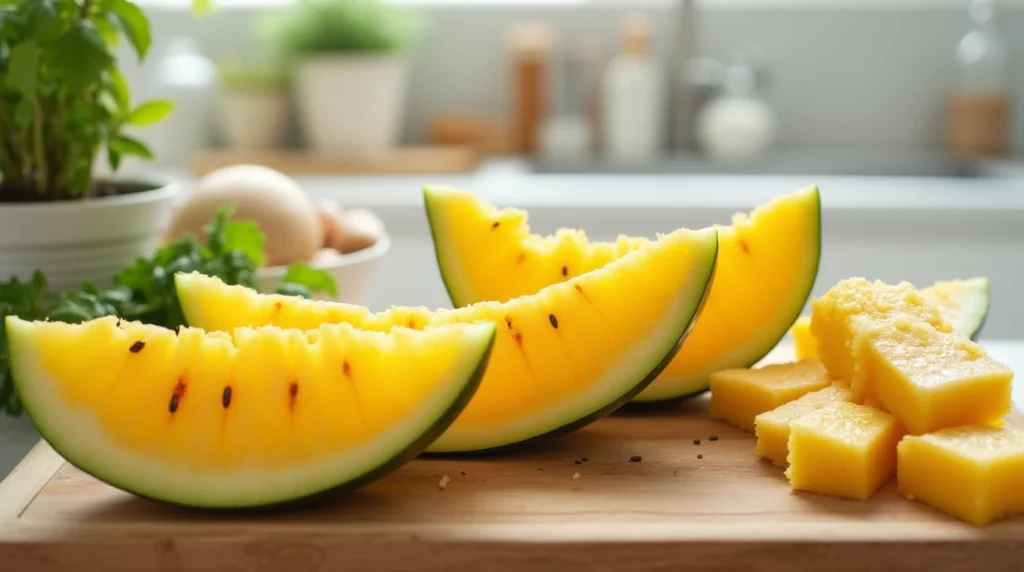Introduction
Have you ever sliced open a watermelon expecting deep red flesh, only to find bright yellow flesh inside? If so, you’ve discovered the sweet and unique yellow watermelon! This variety isn’t just a visual surprise—it has a honey-like taste, is packed with essential nutrients, and has been cultivated for over 5,000 years.
Despite being less common than red watermelon, yellow watermelon is an ancient variety with numerous health benefits and culinary uses. If you enjoy refreshing and naturally sweet treats, check out this mango ice cream recipe—another fruity delight to beat the heat!
But what makes yellow watermelon special? How does it compare to red watermelon? And how can you incorporate it into recipes, smoothies, and desserts? Let’s dive deep into everything you need to know.
What Is Yellow Watermelon?
Yellow watermelon is a naturally occurring variety that lacks lycopene—the pigment responsible for the red color in regular watermelons. Instead, it contains beta-carotene, the same antioxidant found in carrots, giving it its signature golden-yellow hue.
The History of Yellow Watermelon
- Originated in Africa over 5,000 years ago.
- Was one of the first watermelon varieties to exist.
- Early watermelons were mostly yellow or white inside.
- Red-fleshed watermelons only became popular after selective breeding.
- Ancient Egyptians and other civilizations cultivated yellow watermelon for its sweet flavor and hydration benefits.
Yellow watermelons have never been genetically modified—they are simply an ancient variety that was later overshadowed by red watermelons in commercial farming.
Varieties of Yellow Watermelon
Yellow watermelons come in multiple varieties, each with a distinct size, sweetness level, and growth pattern:
1. Yellow Crimson
- Similar in size to red watermelon.
- Sweet and juicy with a mild honey flavor.
2. Yellow Doll
- A small, early-ripening variety.
- Perfect for home gardens and small spaces.
3. Desert King
- Drought-resistant variety, thrives in hot climates.
- Has orange-yellow flesh and a mild, tropical sweetness.
4. Buttercup Yellow Watermelon
- Known for super-sweet flesh.
- Thin rind, making it easy to cut and eat.
5. Yellow Petite
- A compact, seedless variety.
- Perfect for small families and easy refrigeration.
Nutritional Benefits of Yellow Watermelon
Just like red watermelon, yellow watermelon is nutrient-dense, low in calories, and hydrating. Here’s why it’s a superfood:
1. Rich in Antioxidants
- High in beta-carotene, which supports eye health, skin, and immunity.
- Reduces inflammation and supports overall wellness.
2. Hydration Boost
- Contains 92% water, making it one of the most hydrating fruits.
- Helps maintain electrolyte balance, perfect for hot summer days.
3. Supports Heart Health
- High in potassium, which helps regulate blood pressure.
- Contains citrulline, an amino acid that improves circulation.
4. Strengthens Immunity
- Vitamin C-rich, which boosts immune function and aids in collagen production.
5. Aids Digestion
- Contains dietary fiber, promoting gut health and regular digestion.
Looking for another healthy and delicious treat? Try mini chocolate chip cookies to pair with fresh fruit for a balanced dessert!
How to Grow Yellow Watermelon
Growing your own yellow watermelon is rewarding and easier than you think!
1. Best Climate & Soil Conditions
- Prefers warm climates (70-90°F).
- Requires well-draining, sandy soil.
2. Planting & Watering Tips
- Plant seeds in direct sunlight.
- Keep soil consistently moist, but avoid overwatering.
3. Harvesting Yellow Watermelon
- Ready to pick when the underside turns yellow.
- The vine tendrils near the fruit will start to dry out.
For more gardening tips, check out Gardening Know How.
How to Cut and Serve Yellow Watermelon
Step-by-Step Cutting Guide
- Slice off both ends to create a flat surface.
- Cut in half lengthwise for easy handling.
- Slice into wedges or cubes based on preference.
🍉 Best ways to enjoy yellow watermelon:
- Fresh as a snack.
- Blended into smoothies.
- Added to fruit salads.
- As a base for mocktails and cocktails.
- Used in frozen treats like popsicles.
For another irresistible dessert, try these German chocolate cupcakes for a sweet and indulgent treat!
Yellow Watermelon vs. Red Watermelon
| Feature | Yellow Watermelon | Red Watermelon |
|---|---|---|
| Color | Bright yellow | Deep red |
| Taste | Sweeter, honey-like | Mild, classic sweetness |
| Antioxidants | Beta-carotene | Lycopene |
| Hydration | 92% water | 92% water |
| Sugar Content | Slightly higher | Moderate |
Both are nutritious, but yellow watermelon offers a unique flavor and higher antioxidant content.
FAQs About Yellow Watermelon
1. Is yellow watermelon genetically modified?
No! It’s a natural variety that existed long before red watermelons.
2. Can you eat yellow watermelon seeds?
Yes! The seeds are safe to eat and can be roasted for a crunchy snack.
3. How do you tell if a yellow watermelon is ripe?
Look for:
- A deep yellow field spot.
- A hollow sound when tapped.
- Dry tendrils near the stem.
4. Can yellow watermelon be used in cooking?
Yes! It’s perfect for grilling, juicing, and even savory dishes like salsa.
5. Where can I buy yellow watermelon?
- Farmers’ markets.
- Specialty grocery stores (during summer).
- Online fruit retailers.
Final Thoughts
Yellow watermelon is a sweet, refreshing, and nutritious fruit that’s perfect for summer. Whether you’re eating it fresh, in a smoothie, or as a grilled side dish, it’s a delicious addition to any meal.
Next time you see yellow watermelon, don’t hesitate to try it—you might just find your new favorite fruit! 🍉



